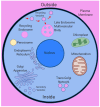Biomolecular Basis of Cellular Consciousness via Subcellular Nanobrains
- PMID: 33802617
- PMCID: PMC7961929
- DOI: 10.3390/ijms22052545
Biomolecular Basis of Cellular Consciousness via Subcellular Nanobrains
Abstract
Cells emerged at the very beginning of life on Earth and, in fact, are coterminous with life. They are enclosed within an excitable plasma membrane, which defines the outside and inside domains via their specific biophysical properties. Unicellular organisms, such as diverse protists and algae, still live a cellular life. However, fungi, plants, and animals evolved a multicellular existence. Recently, we have developed the cellular basis of consciousness (CBC) model, which proposes that all biological awareness, sentience and consciousness are grounded in general cell biology. Here we discuss the biomolecular structures and processes that allow for and maintain this cellular consciousness from an evolutionary perspective.
Keywords: actin; cell; cell biology; consciousness; cytoskeleton; eukaryotes; excitability; membranes; sentience; symbiosis.
Conflict of interest statement
The authors declare no conflict of interest.
Figures


Similar articles
-
Sentience and Consciousness in Single Cells: How the First Minds Emerged in Unicellular Species.Bioessays. 2019 Mar;41(3):e1800229. doi: 10.1002/bies.201800229. Epub 2019 Feb 4. Bioessays. 2019. PMID: 30714631 Review.
-
Cognition in some surprising places.Biochem Biophys Res Commun. 2021 Jul 30;564:150-157. doi: 10.1016/j.bbrc.2020.08.115. Epub 2020 Sep 17. Biochem Biophys Res Commun. 2021. PMID: 32950231
-
Sensing, feeling and sentience in unicellular organisms and living cells.Biosystems. 2025 Jan;247:105374. doi: 10.1016/j.biosystems.2024.105374. Epub 2024 Nov 17. Biosystems. 2025. PMID: 39551428
-
CBC-Clock Theory of Life - Integration of cellular circadian clocks and cellular sentience is essential for cognitive basis of life.Bioessays. 2021 Oct;43(10):e2100121. doi: 10.1002/bies.202100121. Epub 2021 Aug 11. Bioessays. 2021. PMID: 34382225
-
Sentient cells as basic units of tissues, organs and organismal physiology.J Physiol. 2024 Jun;602(11):2491-2501. doi: 10.1113/JP284419. Epub 2023 Oct 17. J Physiol. 2024. PMID: 37847422 Review.
Cited by
-
Technological Approach to Mind Everywhere: An Experimentally-Grounded Framework for Understanding Diverse Bodies and Minds.Front Syst Neurosci. 2022 Mar 24;16:768201. doi: 10.3389/fnsys.2022.768201. eCollection 2022. Front Syst Neurosci. 2022. PMID: 35401131 Free PMC article.
-
Back to square one: the bodily roots of conscious experiences in early life.Neurosci Conscious. 2021 Nov 20;2021(2):niab037. doi: 10.1093/nc/niab037. eCollection 2021. Neurosci Conscious. 2021. PMID: 38633139 Free PMC article.
-
Cellular and Natural Viral Engineering in Cognition-Based Evolution.Commun Integr Biol. 2023 May 2;16(1):2196145. doi: 10.1080/19420889.2023.2196145. eCollection 2023. Commun Integr Biol. 2023. PMID: 37153718 Free PMC article. Review.
-
Towards the Idea of Molecular Brains.Int J Mol Sci. 2021 Nov 1;22(21):11868. doi: 10.3390/ijms222111868. Int J Mol Sci. 2021. PMID: 34769300 Free PMC article. Review.
-
Proteinoid Microspheres as Protoneural Networks.ACS Omega. 2023 Sep 12;8(38):35417-35426. doi: 10.1021/acsomega.3c05670. eCollection 2023 Sep 26. ACS Omega. 2023. PMID: 37780014 Free PMC article.
References
-
- Nurse P. What Is Life? Understanding Biology in Five Steps. David Fickling Book; Oxford, UK: 2020.
-
- Lyons S. From Cells to Organisms: Re-Envisioning Cell Theory. University of Toronto Press; Toronto, ON, Canada: 2020.
Publication types
MeSH terms
LinkOut - more resources
Full Text Sources
Other Literature Sources

